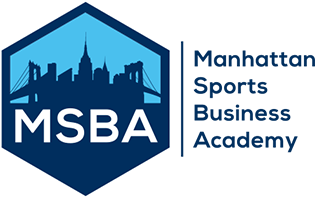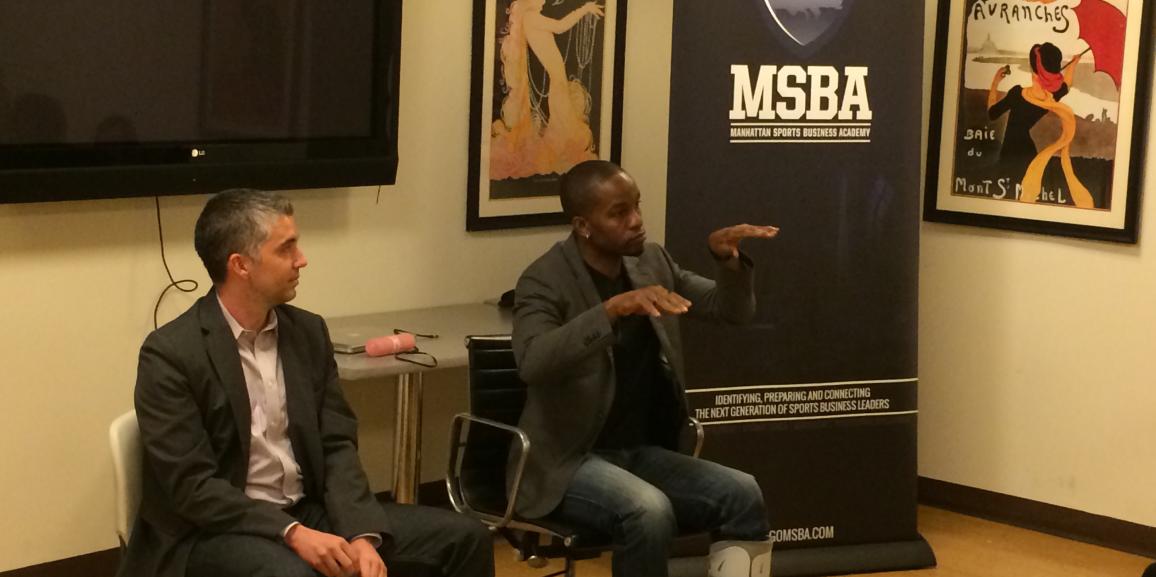Connect with Matt on Facebook.
To wrap up the speaker series for the summer, the MSBA class heard from the Executive Director, Wade Davis, and the President, Patrick Burke, of the non-profit You Can Play Project. Having followed the organization from before its inception, when Patrick’s brother Brendan had bravely come out publicly on ESPN, and watched YCP accomplish seemingly monumental progress without ever seeking the limelight, I was personally beyond excited for this presentation.
Nothing has made me more proud of the hockey community, and to be able to call myself a hockey fan, than to witness the complete buy-in and enthusiastic participation with YCP of the NHL family, from executives and players down to media. It had been somewhat of a personal crusade of mine to be involved with YCP this summer, and prior to enrolling in MSBA, I pursued every possible avenue I could think of to get the attention of the decision makers of YCP, including Patrick and Wade, as well as Brian Kitts and Glenn Witman, the other two cofounders. Aside from Twitter, e-mail, phone calls, and good old-fashioned snail mail, I also managed to track down Patrick at Harvard Business School, where he was the moderator for a panel of LGBT athletes voicing their experiences at their LGBTQ Conference. Although I was ultimately rebuffed due to internal restructuring within the organization, I did not lose my zeal for the organization; indeed, I went so far as to list Patrick on my MSBA application as one of my choice of three individuals, alive or dead, in sports with whom I would most like to have dinner and converse.
Knowing this, and in spite of the fact that MSBA had no contacts within YCP, our amazing program director Lorne Segall persistently pursued Patrick and Wade to be speakers for the program, all while keeping me abreast of the progress. Once the event was confirmed, I did what I could to try to generate excitement for the event, and to try to ensure that the MSBA class would be in full attendance. Once they had an audience, I was certain that Patrick and Wade would know just how to reach them.
In spite of travel issues causing many to arrive late, ultimately almost the entire class arrived, and Patrick and Wade did not disappoint. Although the subject matter of LGBT inclusion and equality in sports is a heavy one, unlike any that had been presented by other speakers this summer, Patrick and Wade kept the tone light, seeking to maintain levity in the room while remaining educational. This tone resonated with the students, as once it was laid out that neither speaker had any intention of filtering their words, and that there truly were no dumb questions, the questions from the group came flying, in greater quantity, and honestly quality, than for any other speaker in the past.
First, however, Patrick and Wade enlightened the group as to how they came to be involved with YCP. Patrick’s tale was one of sadness, as despite having no inclination for non-profit work in the past (and indeed the future beyond YCP), he felt compelled to carry forth Brendan’s legacy, and to continue his crusade for LGBT rights. Brendan’s passing had led him to realize that he has the personality and the platform to continue carrying the torch for this cause, and he embraced it. Thus, YCP was formed in Patrick’s 3L year at New England Law School, in spite of the fact that he was also working as a professional scout for the Philadelphia Flyers and training for a marathon, not to mention dealing with daily classes. Wade’s story, on the other hand, was one of tremendous internal turmoil. As he had only come out publicly in 2012, Wade went through his entire football career living multiple lives as he attempted to keep his secret hidden. Upon first realizing his homosexual inclinations, he turned to bullying, and hyper-masculinity, as he saw these as his only avenues to keep his façade alive. Over time, he came to realize that much of this was “wasted motion” on his part, and following his work with some homeless LGBT children in New York, made the decision to publicly come out to the world.
Ultimately, the goal of the “You Can Play Project” is to educate athletes and teams, and provide resources for similar purposes, so that they are ready and accepting, and understand what protocols to follow, in dealing with a future out teammate or just the LGBT community in general. The speakers understand that inherently nobody wants to be homophobic, and thus everybody must have some inclination to better understand the issues, and to modify their behavior given the proper instructions. However, Patrick and Burke emphasize that the goal should not be to “fix” someone, but rather to, through education, allow them to form their own opinions as to what their right mindset ought to be. Through their decades as part of the athletic community and as players or executives in locker rooms, they are best able to present this message not as holier-than-thou preachers of the gospel, but rather as equals who are there to ensure that the conversations that need to be had occur. They accomplish this in a way that allows everybody a platform to voice their opinion, even if such opinions are counter to what they ultimately wish such players to have, and by ensuring that there is levity to the conversation such that everyone is at ease in confronting an undeniably loaded topic.
Once the foundation was laid, the speakers moved onto a question and answer session in which they used every response to educate the group and attack baseline assumptions that many people had regarding the nature of athletes and homophobia. The foundational tenet of the “You Can Play Project” is that if an athlete has the skill, the work ethic, and the character to contribute to a team, then he or she belongs on that team, regardless of sexual orientation; indeed, the same philosophy can be extended to race, religion, socioeconomic background, and numerous other causes for divide within society. If You Can Play, You Can Play. However, this motto is intentionally structured to provide no guarantees. The emphasis is on equality, not preferential treatment; as Patrick puts it, there is a reason why the slogan begins with the word “if.” The LGBT athlete has to go out and prove that he or she deserves to be included on the team, regardless of sexual orientation, and has to acknowledge that roster decisions must not be made on that basis, regardless of the publicity and media coverage his or her inclusion or exclusion may generate. Additionally, the player’s value to the team must exceed the level of distraction he or she brings forth. Thus, in spite of Chris Kluwe’s adamant support of and work for gay marriage, YCP supported the Minnesota Vikings’ decision to release him, as Kluwe’s performance on the field, as well as his salary and age, no longer justified retention of his services even without taking into account the added distractions he causes.
The speakers, especially Wade, debunked the idea that locker rooms are inherently homophobic spaces. Using the example of Michael Sam, and his experiences at the University of Missouri, Wade was able to provide a counterexample to widely accepted ideas spouted by the media regarding the homophobic nature of Midwesterners, African Americans, and football players. Wade emphasized the idea that every locker room is a brotherhood or sisterhood, with players willing to sacrifice everything they have for their fellow teammates. The homosexual player on the team feels no differently, and his or her teammates understand that sexual orientation does not detract from the shared experiences and sacrifices that the brotherhood or sisterhood has had together, and thus simply does not matter. Patrick emphasized that in their education of teams, they stress that the removal of 5 simple words for your vocabulary can remove 85% of the homophobic issues within a locker room. In his words, “if you aren’t willing to cut just 5 words for your teammates, you’re an asshole.”
The speakers also addressed the misperception that homophobia is not problematic among female teams, in spite of anecdotes provided by several members of the audience. In fact, based on their experiences, while homophobia tends to be a middle of the road issue on most male teams, ranking as approximately a 5 on a scale of 0 to 10, female teams tend to be dealing with either a 0 problem or a 10 problem. It has gotten to the point where, in order to avoid being stigmatized or perceived as lesbian, women will spend hours before any athletic endeavor on their appearance, as if they were contending for the Miss America Pageant as opposed to a basketball game or a tennis match.
Finally, the speakers covered the process necessary to help an athlete with a public coming out process. The first step is always for the athlete to speak to Wade and pass the “sniff test,” to make sure the he or she truly is ready for the public scrutiny that comes with the freedom and opportunity to tell one’s own story. From there, a list of trusted media outlets and journalists are discussed, with one or a few ultimately chosen to simultaneously run the story. Using Lebron James and his two “Decisions” as an example, Patrick demonstrated why such announcements are always made via print, where there is far greater control over the content and phrasing of the news, rather than live on TV, where there is simply no way to prepare for all the possible twists.
The takeaway line for the night, and one that resonated immediately with the group, was one that Patrick calls his current favorite saying. “Homophobia is the fear that gay men will treat you the way you treat women.” It is hard to imagine a more poignant statement than that, in a debate over an issue that is ultimately inseparable from the broader issue of how individuals treat one another overall.

